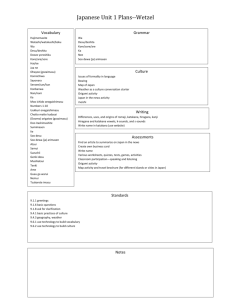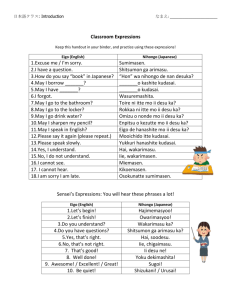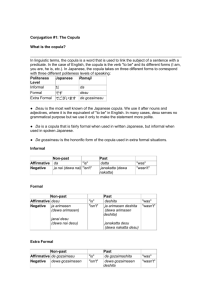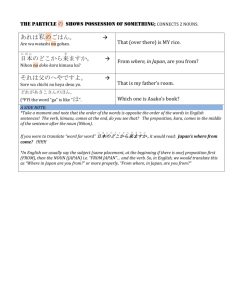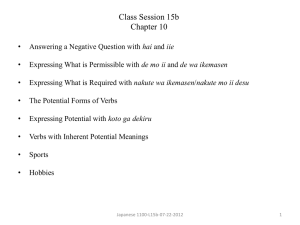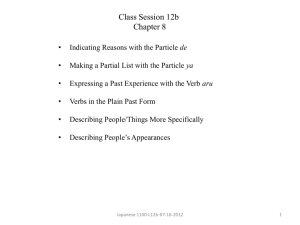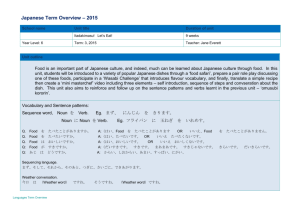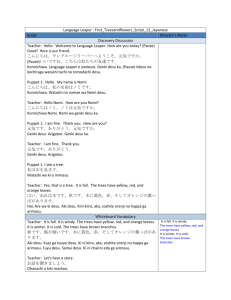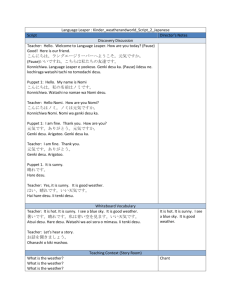File - TOTALLY TOKYO
advertisement
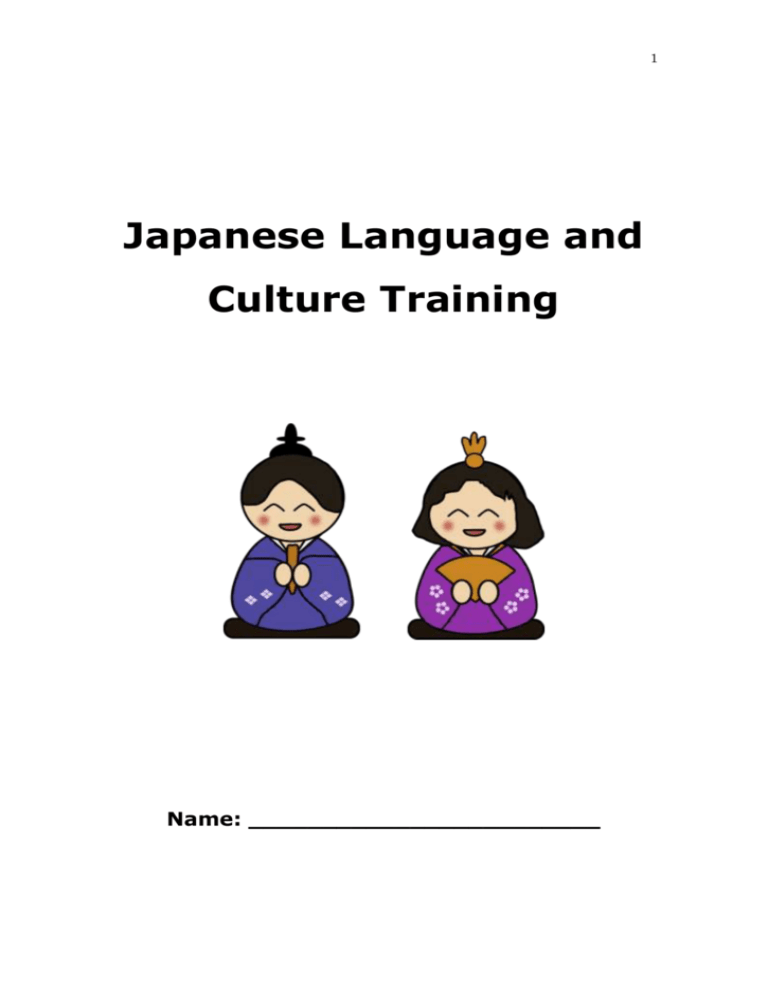
1 Japanese Language and Culture Training Name: ________________________ 2 Japan True/False Quiz Japanese students learn more than 1,500 kanji between 1st grade and the end of high school. T / F T / F T / F T / F T / F Japan consists of 3 main islands: Honshu, Hokkaido, and Kyushu. T / F There are vending machines in Tokyo that have face reading capabilities and offer drink suggestions. T / F T / F Only waiters and waitresses are tipped in Japan. The tallest building in Tokyo is the Tokyo Tower. Most trains arrive within one minute of their scheduled time. The population of Japan is currently more than 100 million. Mt. Fuji is over 13,000 ft. tall. Japanese mixes 4 writing systems Hiragana: consists of 46 characters that make up the basic sounds of Japanese. A few modifications can be made to the characters to create additional sounds. Hiragana is used for words originated in Japan. Hiragana characters look fluid, and were made from abbreviating/simplifying the strokes of certain Kanji. Katakana: consists of the same sounds as Hiragana, but uses different characters. Katakana is used to signify words of foreign origin. Katakana looks more rigid and angled than hiragana. Kanji: characters imported from China that were used to help Japan develop a writing system. There are thousands of Kanji used in Japanese, but the first 200 learned cover about 50% of kanji use, and the first 500 cover about 70%. Romaji: while not a traditional part of the Japanese language, Romaji (literally meaning Roman characters) uses the alphabet to phonetically spell out Japanese words. 3 Pronounce words and write the English translation Romaji English Romaji hoteru conpyuーtaー resutoran makudonarudo takushiー chiーzu English Write your name in Japanese: __________________________________ Self-Introductions Hajimemashite. _____________ desu. Yoroshiku onegai shimasu. “Nice to meet you. I am ___________. Thank you in advance/Best regards/I look forward to our relationship.” 3 Core Parts of Japanese Language Basic structure is Subject-Object-Verb (SOV). The tense comes at the end of the sentence with the verb. Particles between regular words determine the relationship of the words. *Note: The subject is often implied instead of directly stated. There are no plurals in Japanese. Example sentence English: “I went to the store.” The structure is SVO. I: watashi go: ikimasu store: mise went: ikimashita (past tense) Japanese: “(Watashi wa) mise ni ikimashita.” The structure is SOV. wa: particle that is a subject marker ni: particle that indicates movement toward something “Watashi wa” is often left out since it is implied that the speaker is talking about him/herself and sometimes feels redundant if used. Directly translated in order of the words: “I to the store went.” (Yoda speak) 4 Ko/So/A/Do words There are many sets of words that start with ko, so, a, or do that are related in meaning. Ko… words signal something close to the speaker So… words signal something close to the listener A… words signal something far from both parties Do… words signal uncertainty or a question One common set of ko/so/a/do words: Another commonly used set: kore = this koko = here sore = that soko = there are = that (over there) asoko = over there dore = which(?) doko = where(?) Desu/desuka/deshita Desu, desuka, and deshita are ending verbs used for states/conditions. Desu is used to make a statement in present tense. Desuka is used to ask a question. Deshita is used to make a statement in past tense. The particle “wa” The particle “wa” is used to comment on a condition. It is a topic marker. It partly serves a similar function to “is,” “are,” “were,” “was”… The meaning of “wa” can change slightly based on the ending of the sentence, where tense is determined. Example: ~ wa ~ desu = ~ is ~. ~ wa ~ deshita = ~ was ~. ~ wa ~ desuka = is ~ ~? Example sentences with wa: Kore wa ringo(apple) desu. = This is an apple. Sore wa gyuunyuu(milk) desu. = That is milk. Are wa ke-ki desu(cake). = That (over there) is a cake. Kore wa tamago(egg) desuka? = Is this an egg? 5 What is this? Kore wa nandesuka? What is that? Sore wa nandesuka? Is this ~? Kore wa ~ desuka? This is a ~. Kore wa ~ desu. That is a ~. Sore wa ~ desu. Romaji A B pan What is that? This is bread. Sore wa nandesuka? Kore wa pan desu. What is this? That is a banana. banana Sore wa banana orenji jyu-su Kore wa nandesuka? desu. Is this orange juice? Yes, that’s right. Kore wa orenji ko-hi- ringo bi-ru jyu-su desuka? Hai, soudesu. What is this? That is coffee. Kore wa nandesuka? Sore wa ko-hi- desu. What is that? This is an apple. Sore wa nandesuka? Kore wa ringo desu. Is this coffee? No, that’s incorrect. Kore wa ko-hidesuka? Iie, chigaimasu. 6 Introduction to Numbers Counting is contextual in Japanese. The word for “one” is not always the same depending on what is counted. This is similar to the English difference between “one” and “first.” There are many more counting words in Japanese than in English. Numeral Number (General) Counting Objects 1 Ichi Hitotsu 2 Ni Futatsu 3 San Mittsu 4 Shi / Yon Yottsu 5 Go Itsutsu 6 Roku Muttsu 7 Shichi / Nana Nanatsu 8 Hachi Yattsu 9 Kyuu Kokonotsu 10 Jyuu Jyukko 11 Jyuu Ichi Jyuu Ikko 12 Jyuu Ni Jyuu Niko 13 Jyuu San Jyuu Sanko 20 Ni Jyuu Ni Jyukko 21 Ni Jyuu Ichi Ni Jyuu Ikko 22 Ni Jyuu Ni Ni Jyuu Niko 23 Ni Jyuu San Ni Jyuu Sanko 30 San Jyuu San Jyukko 40 Yon Jyuu Yon Jyukko 50 Go Jyuu Go Jyukko 60 Roku Jyuu Roku Jyukko 70 Nana Jyuu Nana Jyukko 80 Hachi Jyuu Hachi Jyukko 90 Kyuu Jyuu Kyuu Jyukko 100 Hyaku Hyakko 200 Ni Hyaku Ni Hyakko 300 San Byaku San Byakko 1,000 Sen Senko 10,000 Man Ichi manko 7 The particle “to” The particle “to” means “and” or “with” Ichigo to banana Strawberry and banana Pan to chi-zu Bread and cheese Write the total price 8 Tenses and Verb Conjugations Depending on how the ending of a verb is changed, the meaning and tense changes Verb conjugations for go (iku) and buy (kau): iku: (will) go kau: to buy ikimasu: will go (polite form) kaimasu: will buy (polite form) ikitai: want to go kaitai: want to buy ikimashita: went kaimashita: bought ikimasen: will not go kaimasen: will not buy ikimasendeshita: did not go kaimasendeshita: did not buy ikimashou: let’s go kaimashou: let’s buy ikimasuka: will you go? kaimasuka: will you buy? Fill in the following table for verb conjugations: English Present Past Let’s… Want to… Will you…? Will not… ---------- …masu …mashita …mashou …tai …masuka …masen Go Ikimasu Go home Kaerimasu Eat Drink Ikimashou Tabemashita Ikitai Ikimasuka Kaeritai Kaerimasuka Tabetai Nomimasu Buy Ride Ikimashita Ikimasen Tabemasen Nomimasuka Kaimashita Norimasu Kaimasen Norimashou The particle “o” The particle “o” is a direct object marker. Ringo o tabemashita. I ate an apple. Gyuunyuu o kaimashou. Let’s buy milk. 9 The particle “ni” (for movement) The particle “ni” has multiple uses. A common use is to indicate direction of movement. Kichijoji ni ikimasu. I will go to Kichijoji. Shinjuku ni ikitai. I want to go to Shinjuku. Translate to Japanese 1) I want to go to Mitaka. 2) Will you go to Shibuya? 3) I will go to Musashisakai. 4) I went to Roppongi. 5) Let’s go to Higashi Koganei. 6) I will not go to Fuchu. Fill in the Japanese translation How much is ~ ? Please take care See you next time What is this? Good bye Where is (the) ~ ? Yes, please See you later What time is it? Good bye (after work) / Nice work today 10 Pronouns and personal belongings I / me watashi you anata him kare her kanojo shirt shyatsu pants zubon shoes kutsu socks kutsushita hat boushi jacket jyaketto wallet saifu cell phone keitai The particle “no” (for possession) The particle “no” is often used to indicate possession. Sore wa watashi no shyatsu desu. That is my shirt. Kore wa anata no boushi desu. This is your hat. Kare no saifu wa doko desuka? Where is his wallet? Translate to Japanese That is my cell phone. This is his jacket. Where is my wallet? That is her hat. These are your socks. Where is his shirt? 11 Words around town station eki taxi stand takushi- noriba convenience store conbini super market su-pa- Relative position words North (side) kita (gawa) South (side) minami (gawa) East (side) higashi (gawa) West (side) nishi (gawa) The particle “no” (for relative positions) The particle “no” can be used to indicate relative positions. The particle “ni” (for location marker) The particle “ni” can be used as a location marker. Arimasu / Imasu “Arimasu” is used as a verb to tell where objects / plants are located. “Imasu” is used to as a verb to tell where people / animals are located. Tying it together Conbini wa eki no kita gawa ni arimasu. The convenience store is on the North side of the station. Su-pa- wa eki no nishi gawa ni arimasu. The supermarket is on the West side of the station. Pattern: NOUN-1 wa NOUN-2 no LOCATION ni arimasu. 12 Phrase Matching (Yes), that’s correct ~ wa doko desuka? Nice to meet you ~ wa ikura desuka? (No), that’s incorrect Hai, soudesu Where is (the) ~ ? Hajimemashite Good evening Iie, chigaimasu How much is ~ ? Konbanwa What is this? Konnichiwa Yes, please Kore wa ~ desu This is a ~ Kore wa ~ desuka? Hello (during the day) Kore wa nandesuka? What time is it? Nanji desuka? Is this ~ ? Onegaishimasu Excuse me Sore wa ~ desu That is a ~ Sou desuka? Thanks in advance Sumimasen Is that so? Wakarimasen I don’t know / understand Yoroshiku onegaishimasu 13
